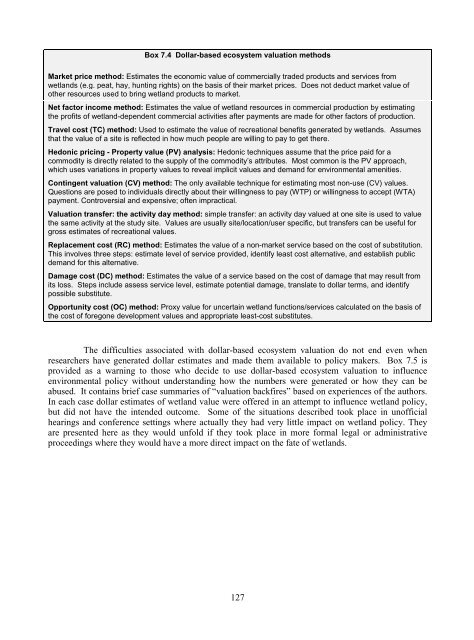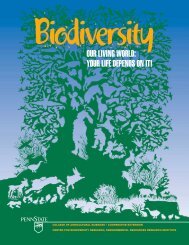Valuation of Biodiversity Benefits (OECD)
Valuation of Biodiversity Benefits (OECD)
Valuation of Biodiversity Benefits (OECD)
- No tags were found...
Create successful ePaper yourself
Turn your PDF publications into a flip-book with our unique Google optimized e-Paper software.
Box 7.4 Dollar-based ecosystem valuation methodsMarket price method: Estimates the economic value <strong>of</strong> commercially traded products and services fromwetlands (e.g. peat, hay, hunting rights) on the basis <strong>of</strong> their market prices. Does not deduct market value <strong>of</strong>other resources used to bring wetland products to market.Net factor income method: Estimates the value <strong>of</strong> wetland resources in commercial production by estimatingthe pr<strong>of</strong>its <strong>of</strong> wetland-dependent commercial activities after payments are made for other factors <strong>of</strong> production.Travel cost (TC) method: Used to estimate the value <strong>of</strong> recreational benefits generated by wetlands. Assumesthat the value <strong>of</strong> a site is reflected in how much people are willing to pay to get there.Hedonic pricing - Property value (PV) analysis: Hedonic techniques assume that the price paid for acommodity is directly related to the supply <strong>of</strong> the commodity’s attributes. Most common is the PV approach,which uses variations in property values to reveal implicit values and demand for environmental amenities.Contingent valuation (CV) method: The only available technique for estimating most non-use (CV) values.Questions are posed to individuals directly about their willingness to pay (WTP) or willingness to accept (WTA)payment. Controversial and expensive; <strong>of</strong>ten impractical.<strong>Valuation</strong> transfer: the activity day method: simple transfer: an activity day valued at one site is used to valuethe same activity at the study site. Values are usually site/location/user specific, but transfers can be useful forgross estimates <strong>of</strong> recreational values.Replacement cost (RC) method: Estimates the value <strong>of</strong> a non-market service based on the cost <strong>of</strong> substitution.This involves three steps: estimate level <strong>of</strong> service provided, identify least cost alternative, and establish publicdemand for this alternative.Damage cost (DC) method: Estimates the value <strong>of</strong> a service based on the cost <strong>of</strong> damage that may result fromits loss. Steps include assess service level, estimate potential damage, translate to dollar terms, and identifypossible substitute.Opportunity cost (OC) method: Proxy value for uncertain wetland functions/services calculated on the basis <strong>of</strong>the cost <strong>of</strong> foregone development values and appropriate least-cost substitutes.The difficulties associated with dollar-based ecosystem valuation do not end even whenresearchers have generated dollar estimates and made them available to policy makers. Box 7.5 isprovided as a warning to those who decide to use dollar-based ecosystem valuation to influenceenvironmental policy without understanding how the numbers were generated or how they can beabused. It contains brief case summaries <strong>of</strong> “valuation backfires” based on experiences <strong>of</strong> the authors.In each case dollar estimates <strong>of</strong> wetland value were <strong>of</strong>fered in an attempt to influence wetland policy,but did not have the intended outcome. Some <strong>of</strong> the situations described took place in un<strong>of</strong>ficialhearings and conference settings where actually they had very little impact on wetland policy. Theyare presented here as they would unfold if they took place in more formal legal or administrativeproceedings where they would have a more direct impact on the fate <strong>of</strong> wetlands.127












